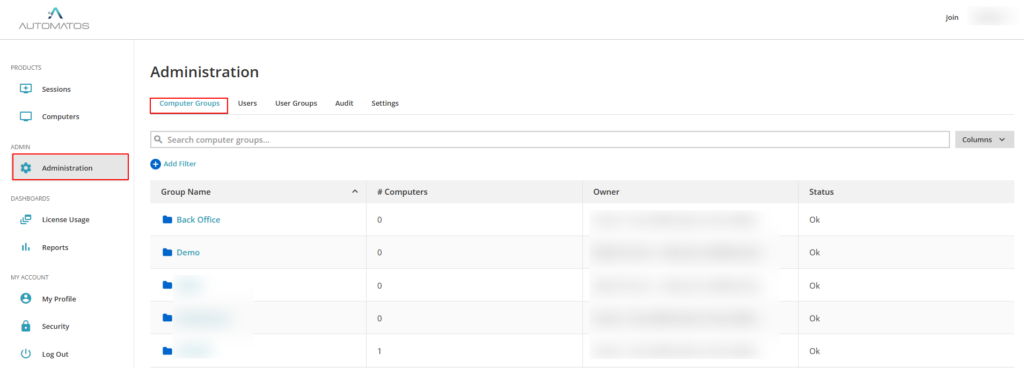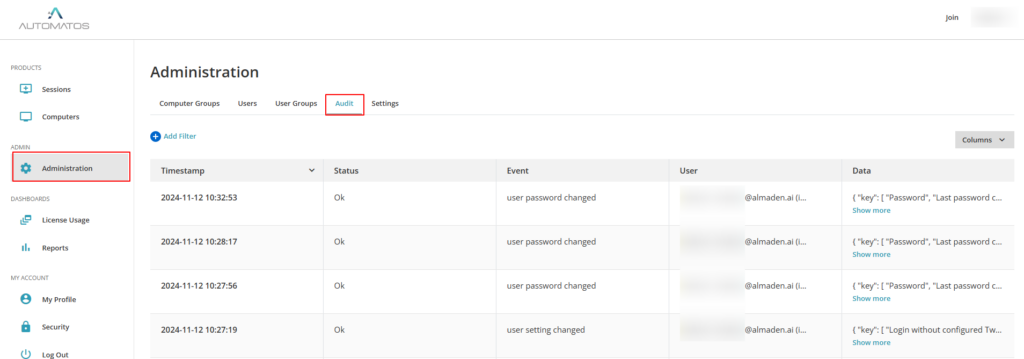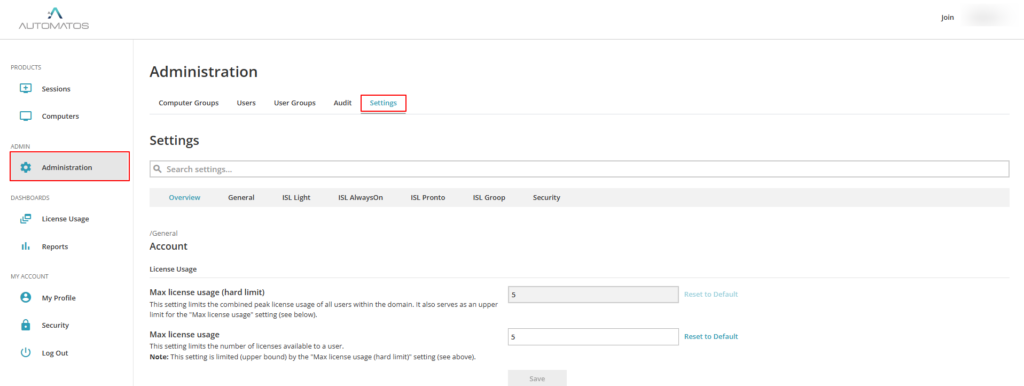Administration
Introduction
To simplify the management of computers and users, we have introduced the Administration pages with many useful features. Here, you can get an overview of all computer groups, users, and user groups. Additionally, you can access the Audit section to view and filter all events within the Administration pages and configure settings at the domain or user level.
Note: The Administration pages can only be accessed by Domain Admin users. The Account Owner is a Domain Admin by default, and you can promote other users to Domain Admin by navigating to:
Administration > Users > Select User > Settings > General and setting the “Domain Admin” option to “Enable”.
Computers
The Computers page displays all remote computers associated with your account, including those registered by users created under your account. It gives you a central location to manage computers, view key information, and organize them into groups for easier access control.
Key Features:
- See All Computers: View all remote computers linked to your account, including those registered by users within your domain.
- Change Group: Move computers between groups to organize them.
- Change Owner: Reassign ownership of a computer to another user. Note: If a computer is added to a Computer Group, ownership is automatically transferred to the Group Owner. The group owner can be changed by users with the appropriate permissions (e.g. Group Admin, Computer(s) Manager, or Computer Owner).
- Share Computer: Share access to a specific computer with users or user groups in your domain. You can also assign connect-only access to limit permissions. Note: For easier management and advanced permission controls (such as setting access levels or automating sharing for newly added computers), we recommend sharing via Computer Groups instead of individual computers.
- Computer Details: The table displays columns such as Alias, Computer Name, Status, Last Online, Computer Group, Owner, Shares, Tags, Platform, Agent Version, IP Address, and MAC Address.

The Web Portal > Administration > Computers page allows you to view and manage detailed properties of each computer, but it does not support bulk operations such as changing access passwords, upgrading agent, deleting computers, or performing multiple actions at once.
To perform these actions, use the main Computers page (Web Portal > Computers section), which displays all computers you own or those shared with you.
If a computer is not visible or manageable via the Computers interface, you can still access and modify it under Administration > Computers. From there, you can either:
- Change the owner to yourself, or
- Share the computer with a Computer Group where you are the Group Owner, or the group is shared with you with Group Admin permissions.
Once these conditions are met, the computers will appear in your Computers dashboard (in both the Web Portal and ARC Viewer). From there, you’ll be able to perform actions such as connecting to computers, deleting them, changing access passwords, upgrading the ARC Server , and more.
Computer Group
The Computer Groups page provides an overview of all Computer Groups in your account.

Group Owner
The owner of the computer group is the user who created the group. This user can edit and delete computers within the group, as well as perform actions on them.
Members – Members (users or user groups) of the Computer Group can be granted access to all computers within the group. Additionally, the following permissions can be set:
a.) Connect Only – Members with this permission can connect to computers within the Computer Group.
b.) Computer Manager – Members with this permission have the same access as “Connect Only” members, but they can also edit and delete computers and perform actions on them.
c.) Group Admin – Members with this permission have the same access as “Computer Managers”, but they can also share access and change the group’s permissions. Each Computer Group must have at least one Group Admin.
Users
The Users page allows you to create new users and assign accounts. You can also manage existing users by editing their full names, email addresses, and changing or resetting their passwords. Additionally, you can define specific permissions for each user, such as assigning license limits or disabling certain features.

User Groups
The User Groups page allows you to create user groups and add users to them. The main purpose of User Groups is to group users based on specific characteristics, such as department. By creating a User Group for a department, you can grant access to specific computers or computer groups for the entire department and define their permissions.
For example, you might have a User Group called “Administrators” that requires access to multiple computers or computer groups. By sharing these computers or groups with the “Administrators” User Group, new team members will automatically gain access to these resources once added to the group. If a user no longer needs access, they can easily be removed from the group.

Audit
The Audit page provides an overview of all events occurring within the Administration pages. You can filter events by type, such as “user created”, and see when they occurred, whether they were successful, who initiated the action, and the raw event data. You can also filter results by user, event, timestamp, and more.

Settings
The Settings pages allow you to change domain settings that affect all users. You can manage scheduled access times for computers, require two-factor authentication, set password length and complexity requirements, and more. Note that these settings can also be enabled or disabled at the user level by going to: Administration > Users > User Settings

Usually, there are three values that can be used, since most of these settings can be applied at the server level (server license only), domain level, or user level:
- Enabled
- Disabled (allows override): The setting is disabled, but can be overridden at a lower level.
- Disabled (prevents override): The setting is disabled and CANNOT be overridden at a lower level.
Let’s list some configuration types:
Domain Admin
When enabled, this allows access to the Administration pages. It is recommended to enable this setting at the user level only.
Maximum License Usage
This setting limits the number of licenses available to a user.
Scheduled Sessions (in UTC)
This setting specifies the days and times the user is allowed to start a session. Sessions outside the scheduled time will be rejected.
Skip Authentication at Login (guest operator)
When enabled, operators can invite guest operators (without a user account) to their sessions.
Login Without Configured Two-Factor Authentication
Disabling this option will enforce Two-Factor Authentication for the user(s). Users will be required to configure Two-Factor Authentication on their next login attempt if they do not have at least one method set up.
Reports
From the “Reports” tab you can access the more detailed usage and history reports for the “Automatos Remote Control Viewer” products as well as more general reports for your account.

Licence Usage
This menu allows you to view active sessions and manage them by forcing the session to end if necessary.


